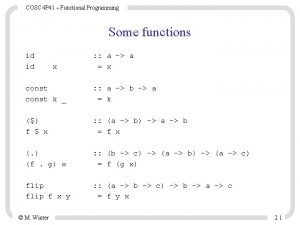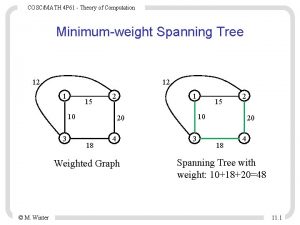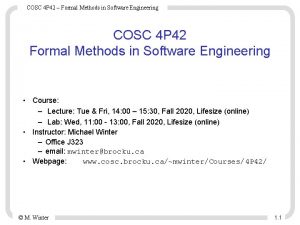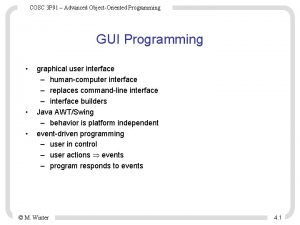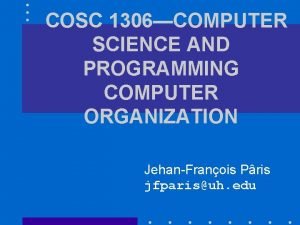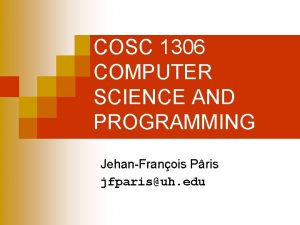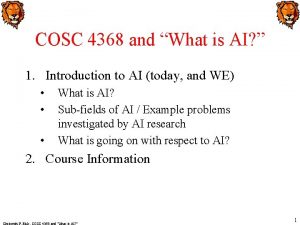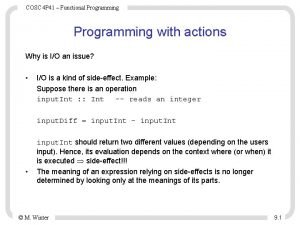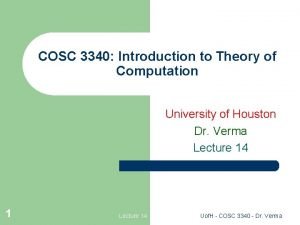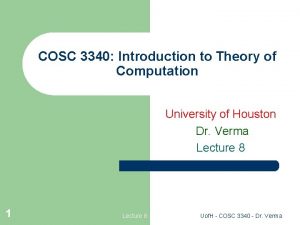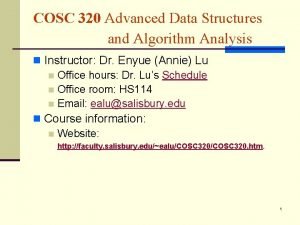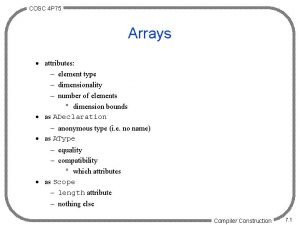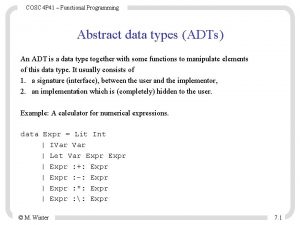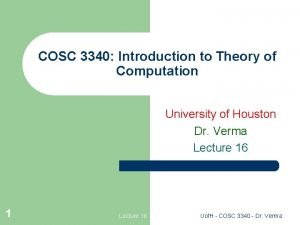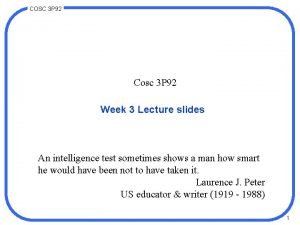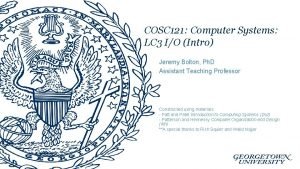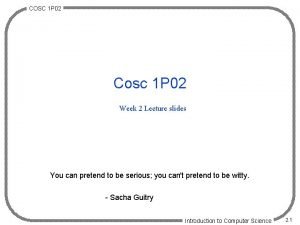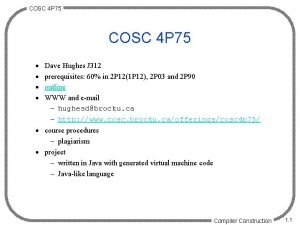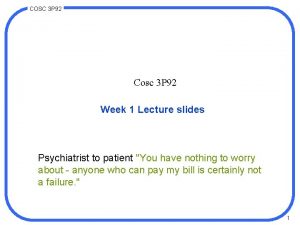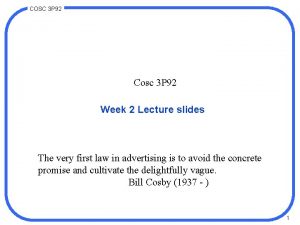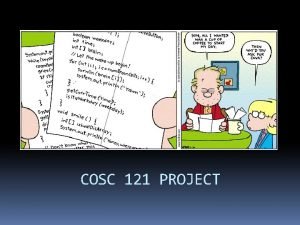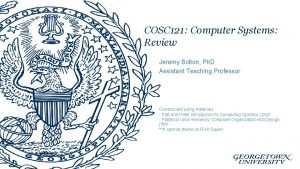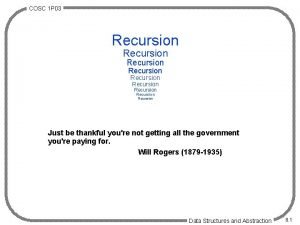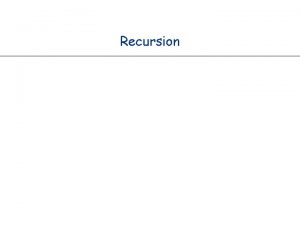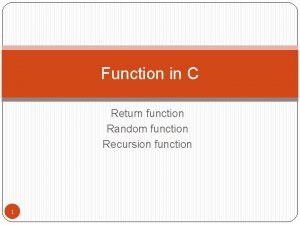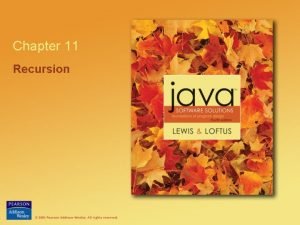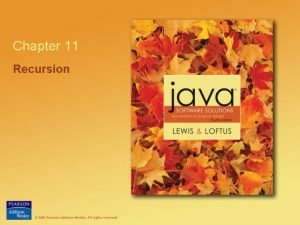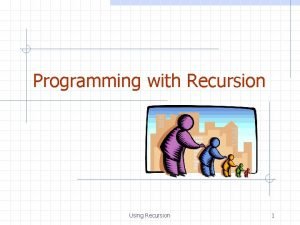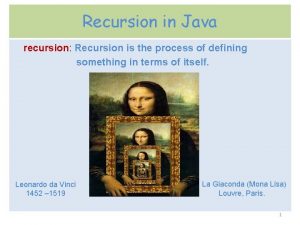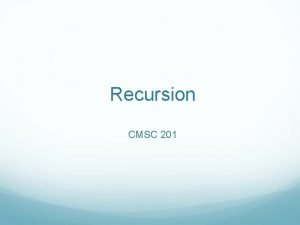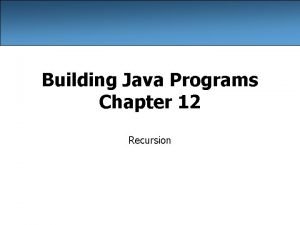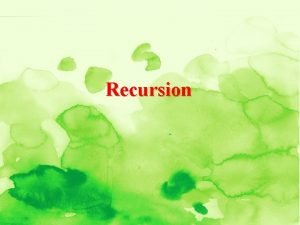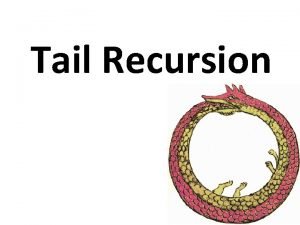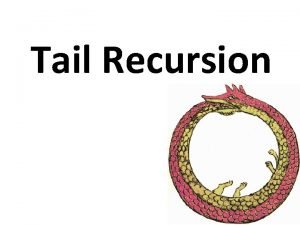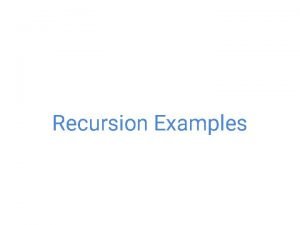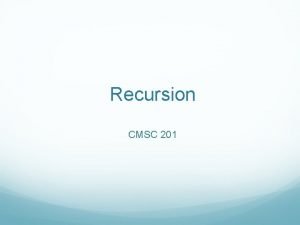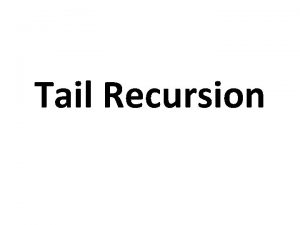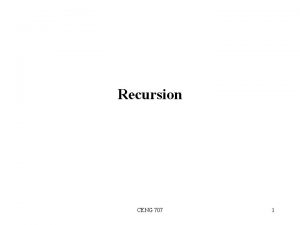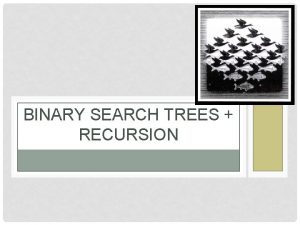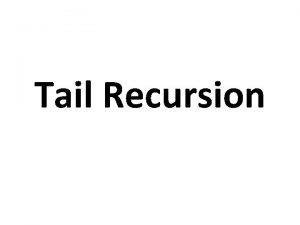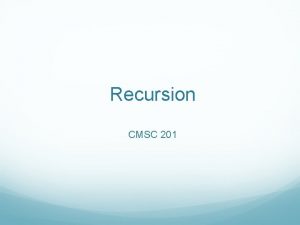Cosc 2030 Recursion Recursion Recursion is a function















![efficient version int binary. Search(int an. Array[], int first, int last, int target) { efficient version int binary. Search(int an. Array[], int first, int last, int target) {](https://slidetodoc.com/presentation_image_h2/cf4799ab991971b087055a86924a8fe9/image-16.jpg)


![code for a finding largest value. int max. Value(int an. Array[], int first, int code for a finding largest value. int max. Value(int an. Array[], int first, int](https://slidetodoc.com/presentation_image_h2/cf4799ab991971b087055a86924a8fe9/image-19.jpg)




- Slides: 23

Cosc 2030 Recursion

Recursion • Recursion is a function call to the same function calling it.

Recursion • Recursion is a function call to the int fib(int f) { same function calling it. if (f ==1) { • It's pretty common in math return 1; formulas } else if (f ==2) { • The Fibonacci sequence is a good return 1; example of it } else { • Fn = Fn-1 + Fn-2 • Where F =1, and F =1 return fib(f-1) + fib(f-2); • 1, 1, 2, 3, 5, 8, 13, 21, 34, . . . } 1 2

Fibonacci sequence starting with 5 Fib(5) fib(4) fib(3) fib(2) fib(1)

Fibonacci sequence starting with 6 fib(6) Fib(5) fib(4) fib(3) fib(2) fib(1) fib(3) fib(2) fib(1)

Types of recursion • Linear Recursion • The function makes a single call to itself each time. • Tail Recursion • Linear recursion, but the call is at at the end of function. • Normally can be rewritten without recursion as well. • Binary Recursion • Has two recursive calls • Like Fibonacci sequence • Exponential recursion • if you were to draw out a representation of all the function calls, would have an exponential number of calls in relation to the size of the data set • Nested Recursion • One of the arguments to the recursive function is a recursive call to itself. • Mutual Recursion • Two or more functions are call each other. • A calls B • B calls A

Linear recursion • Let's print a string backward using recursion void prt_backward(string text) { int length = text. size(); if (length >0 ) { //now send the rest of the string prt_backward(text. substr(1, length)); //print our character. cout <<text. at(0); } • This is pretty simple without recursion • using a loop, start at the end and work backward. }

progression of prt_backward with "cat" received "cat" • called "at" • print c received "at" • called "t" • print a received "t" • called "" • print t received "" • empty return

Question void prt_backward(string text) { int length = text. size(); if (length >0 ) { //print our character. cout <<text. at(0); //now send the rest of the string prt_backward(text. substr(1, length)); } } • What the output of the code called with "cat"?

data structure: an array • an array a simple data structure and when combined with recursion • Arrays can be a practical and powerful data structure. • a major class of recursive algorithms are called "Divide and Conquer" • Each recursive call divides the data into a smaller section and then deals with it.

Search • Say we need to search the data for answers • example is a piece of data in the data set? • spelling for example, is the word in a dictionary? • What the max or min of the data? • There a number of search based queries.

Question: the Data? • So let assume we read a long list of integers into an array. • What is the order of the data? • Is it sorted or unordered?

Binary search • If the data is sorted, then we use a binary search of an array. • each level of recursion will cut the search space of the data in half • it leads to one spot where the data should exist. binary. Search(array, target) if array is of size 1 return is array equal to target else find midpoint of array if (is target in first half of the array) binary. Search(first half of the array, target) else binary. Search(second half of the array, target)

binary search implementation • First to save memory space, we are not going to send smaller array, instead we are going to send array indexes • second we will return the index of value if found, or -1 if not found. int binary. Search(int an. Array[], int first, int last, int target) • array size of 1 is a simple if (first == last) • determine the mid point is now trivial int mid = (first + last) /2; • which half if (target < an. Array[mid]) • and first/second half is easy as well. binary. Search(an. Array, first, mid-1, target) //first half binary. Search(an. Array, mid, target) //second half

efficiency issue. • What is the mid point on the first call has the target value? • in an array of say 100, and the target is at 50. • We would call with size of 100, then 50, then 25, then 13, then 7, 4, 2, 1 • 8 unnecessary calls. • Let's change the base case to 2 cases • 1 if the an. Array is empty • changes second call to binary. Search(an. Array, mid+1, target) • 2 if the an. Array[mid] == target
![efficient version int binary Searchint an Array int first int last int target efficient version int binary. Search(int an. Array[], int first, int last, int target) {](https://slidetodoc.com/presentation_image_h2/cf4799ab991971b087055a86924a8fe9/image-16.jpg)
efficient version int binary. Search(int an. Array[], int first, int last, int target) { if (first > last) return -1; //target is not in the array. else { int mid = (first + last) /2 ; if (target == an. Array[mid]) return mid; //found the target else if (target < an. Array[mid]) return binary. Search(an. Array, first, mid-1, target); //first half else return binary. Search(an. Array, mid+1, last, target); //second half } }

examples array is {1, 5, 9, 12, 15, 21, 29, 31} search for 9 (successful) target =9 first=0 last=7 mid=3 target < an. Array[3] search for 22 (unsuccessful) target =22 first=0 last=7 mid=3 target > an. Array[3] target =22 first=4 last=7 mid=5 target =9 first=0 last=2 mid=1 target > an. Array[1] target > an. Array[5] target =22 first=6 last=7 mid=6 target < an. Array[6] target =9 first=2 last=2 mid=2 target = an. Array[2] return 2 target =22 first=6 last=5 first > last return -1

finding the largest value • Sorted array • trivial. It's at the end of the array (assuming ascending sort) • unsorted array • you could construct an iterative solution that goes through the array searching for the largest value. • you could also construct a recursive version using divide and conquer method. • It would be binary recursion, since we need to search both directions. • unlike binary search where we searched in only one direction.
![code for a finding largest value int max Valueint an Array int first int code for a finding largest value. int max. Value(int an. Array[], int first, int](https://slidetodoc.com/presentation_image_h2/cf4799ab991971b087055a86924a8fe9/image-19.jpg)
code for a finding largest value. int max. Value(int an. Array[], int first, int last) { if (first == last) { return an. Array[first]; //only element, so it must be the max. } else { int mid = (first + last) /2 ; return max(//max of the two return values. max. Value(an. Array, first, mid), max. Value(an. Array, mid+1, last )); } }

example using an. Array ={1, 6, 8, 3} first=0, last=3, mid =1 first=0, last=1, mid=0 first=0, last=0 first=1, last=1 first=2, last=3, mid=2 first=2, last=2 Will this structure change for 4 items? first=3, last =3

Question • Will the recursive method work for a sorted list?

Question (2) • Data can drive the solution. • in find the max value, if you always know the array was sorted • no search, it get the value. • Question? • Should we sort the data first then? • This is a question of efficiently and speed. • Is it faster to sort the data and then pick or just find the value? • One we can answer generally by the end of the course and cosc 3020 can answer formally.

Q&A
